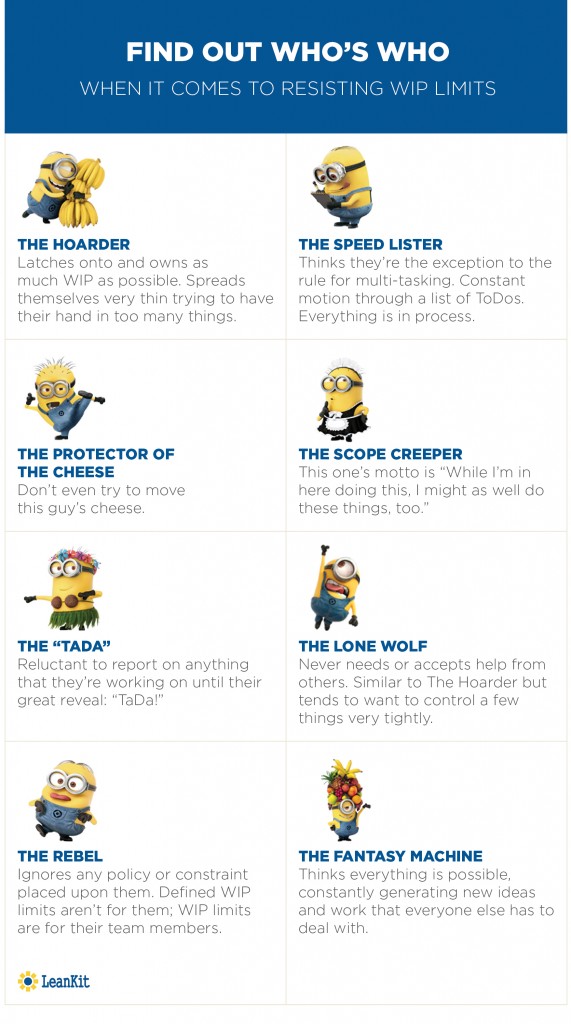
It sounds counter-intuitive, but limiting your work in process (WIP) actually improves your flow — and your team’s productivity. In this three-part series, Stephen Franklin, CIO at Planview AgilePlace, draws from experience to explain the common obstacles you’ll face when setting WIP limits, and tips for overcoming them.
In part one of this blog series, I discussed why limiting the amount of work you have in process can be so inherently difficult. Now that you’re aware of the mindset needed to implement work-in-process (WIP) limits successfully, it’s time to venture a little further into the unknown.
There are three different perspectives to consider when managing WIP limits: personal, team and organizational. A common mistake is to assume that the same approach for managing WIP limits will be effective at each of those levels. Take it from me that it won’t. In this post, I’ll share some of the observations, ideas and lessons that I’ve learned about managing WIP limits at the team (execution) level and at the organizational (structural) level.
Note: The more people feel comfortable with the idea of limiting their personal WIP, the more receptive they’ll be at the team and organizational levels. If you’re new to WIP limits or want to know more about personal WIP limits, I recommend watching this recent webinar by Jim Benson and Tonianne DeMaria Barry, creators of Personal Kanban.
Managing Team (Execution) WIP Limits
At the team or execution level, one of the primary purposes of constraining WIP is to ensure a smooth flow of work through the system, thus reducing the amount of time it takes to deliver value to the customer. Limiting the team’s WIP serves as the “lever” to implement a pull system so the amount of work to be executed matches the capacity of the team. While it sounds straightforward in theory, in practice there are a number of challenges you’ll need to be prepared for.
Three Common Challenges for Team WIP Limits
Variability. I’ve yet to work with a team that doesn’t confront massive levels of variability. Variability can be found in the form of demand, the nature and complexity of the work, associated risks, the cost of delays, outside expectations and influences, individual performance, team performance, interpersonal relationships, skill availability, outside dependencies, and the list goes on. Trying to get your head around each variability in isolation is challenging enough. Understanding the combined effect of these curves can be mind-boggling.
Constraints. This challenge is tightly coupled to variability. We know that system constraints, or bottlenecks, define the overall capacity of the system. It would be extremely nice if a constraint remained stationary and consistent, but I’ve yet to be lucky enough to run across one that behaves so politely. Instead, I’ve found that the high variability of the system often prevents us from stabilizing the constraint, i.e.,“nailing the Herbie.” This makes it difficult at any point in time to confidently determine the capacity of the system.
Interpersonal Dynamics. Introducing new concepts and change into a group can be tricky. This is especially true when it involves moving people outside of their natural state (see previous post). Inevitably, there will be members on your team who resist the idea of limiting WIP, but they might not show it in obvious ways.
What I’ve Learned
At the team level, there tends to be a lot of turbulence. Many risks come to fruition and introduce micro-currents that jostle things around. Constraining the amount of work in process provides flexibility to adapt to constant change. As we allow the system to get closer to its capacity, we are effectively changing state from a gas to a liquid to a solid. We move from a low friction, adaptable environment to a rigid, immovable system that cannot adapt to change.
To keep the system agile it’s essential to maximize your options. The more tightly you pack work into the system the more you impede its agility, thereby reducing the options you have available to respond to change.
For those of you who have previously experienced success in helping a team limit its WIP, remember to be flexible. A mistake that I’ve made in the past is trying to manage WIP limits the same in every situation. After finding an approach that worked for one team, I wanted to apply the exact same methods in other areas. Not surprisingly, the outcomes were inconsistent.
The nature of work and demand is different for each team. The characteristics and culture of teams can also differ significantly. If we don’t take these factors into account, people and teams will drift back to their natural state. While there are common patterns that can be applied to all knowledge-based work, there are also key differences that make applying a one-size-fits-all approach impractical.
Managing Organizational (Structural) WIP Limits
Limiting the strategic focus of the organization is less about flow and more about clear focus and direction. Examples include limiting the number of concurrent strategic initiatives, the active projects in your portfolio or the number of new product features being developed.
The goal is to define the work that delivers the most value to the organization, thus giving the teams responsible for executing the work a clear vision of the bigger picture. I think of this type of work definition as structural, providing the blueprints and superstructure of the work that will be done at lower levels. Structural and systems thinking tell us that more than 90% of the root causes of problems are systemic or structural, so taking the time to get this right is extremely important.
Depending on the scale of the organization, there will be varying strategic levels to consider. These can range from the executive team defining the company strategy to the manager defining initiatives for the department.
Four Actions to Make Organizational WIP Limits Easier
Limit your options. Strategic ideas are typically conceptualized far quicker than they can be executed. Our natural human bias is to be overly optimistic and not consider all of the risks. As a result, we tend to introduce more structural initiatives than we have the capacity to work on. This has the unintended consequence of generating 10x-100x more work for teams at the execution level. Most organizations have a near limitless number of options for their time, money and people. This is the major factor preventing organizations from gaining focus and results in context switching. If you recognize that context switching is costly at the personal and team levels, imagine the exponential cost at the organizational level.
Rotate your perception of the “system” 90 degrees. Your system incorporates top to bottom capacity, as well as the entire value stream at the execution level. Understanding along both of these planes is very difficult, especially as an organization scales in size. The team of executives must not view itself as an isolated system but understand that the WIP defined at strategic level should be driving all of the work at the levels below. Therefore, they should manage their WIP (the work being delegated downward) using the same concepts applied at the team level. Loading an organization to 100% capacity at the strategic level has the same effect as it does at the execution level: total gridlock.
Give yourself permission to limit WIP and strategic focus. Most managerial leaders and teams do not know what to focus on and do not have a clear direction for themselves and their teams. It takes a lot of discipline and mental gymnastics for a leadership team to come up with a compelling shared vision.
Recognize that WIP limit violations can occur from the top down and the bottom up. Top-Down WIP violations occur when in-process work at the higher level exceeds the capacity of the lower level system. This tends to be a common-but-seldom-acknowledged situation in many organizations (as most of us have probably experienced). Bottom-Up WIP Limit violations occur when additional work is introduced at a lower level that does not align with the parent system’s work. It requires diligence and visibility to prevent these violations.
What I’ve learned
Executives and management groups often struggle with limiting strategic focus. This can be caused by a fear of lost opportunities, which is often coupled with not being able to truly measure and understand institutional capacity. Leadership teams need to realize that every opportunity isn’t achievable in parallel.
The responsibility of the leadership team is to perform the hard analysis needed to determine the best opportunities. Then, they need to make sure that the opportunities match the capacity and risk tolerance of the lower systems. This shared vision is the secret sauce for driving focus and alignment within an organization. Without this, companies will never reach their potential. The inability to manage WIP at the strategic level will almost certainly guarantee loss of focus and misalignment at the execution level. I would be willing to bet that most of us have seen the effects of this situation.
Managing Interpersonal Dynamics and WIP Limits
Earlier I touched on interpersonal dynamics and that there will be people who struggle with WIP limits in different ways. This holds true at both the team and organizational levels. WIP limit resistance can often be the most difficult hurdle to overcome. I’ve had to teach myself to be very mindful of all the different perspectives and characteristics that need to be managed when trying to reduce the amount of WIP.
Even the most well-intentioned people can develop bad habits that can derail a team’s effort to limit WIP if left unaddressed. Below is a light-hearted attempt to codify some of the common behaviors, in persona form, that can impede efforts to limit WIP.

Takeaways So Far
There are two key aspects to consider when introducing WIP Limits: the human factor and the practicalities of how you’re going to manage it.
We’ve discussed the challenges you can expect to encounter at the team and organizational levels and the resistance you’re likely to encounter. All that aside, one of our core beliefs at Planview AgilePlace is that people want to do their best work. We also believe that most problems can be attributed to failures in the system.
Change management requires us to understand human dynamics and interactions. Most of us have plenty of scar tissue built up from working within dysfunctional systems. We develop defensive behaviors that protect us from those abusive systems. At the team and sometimes the organizational level, these behaviors can wreak havoc with efforts to constrain the WIP within a system.
In my career, I have seen many of these behaviors detrimentally affect team performance and productivity. Being able to recognize these behaviors and coach them back into a healthy system can serve the individuals, team and organization well.
In the final part of this series, I’ll share practical advice on how to limit WIP at the team and organizational levels as well as lessons learned from the trenches at Planview AgilePlace.




